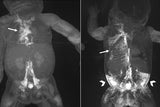
Researchers at Children’s Hospital of Philadelphia (CHOP) have shown that modern, minimally invasive lymphatic imaging techniques help diagnose the precise nature of lymphatic disorders in infants, which helps direct treatment strategies and provides important prognostic information. The findings were recently published in the Journal of Perinatology.

Neonatal chylothorax (NCTx) and central lymphatic flow disorder (CLFD) are neonatal lymphatic disorders with high morbidity and mortality and historically have presented challenges when it comes to diagnosis and treatment. NCTx involves accumulation of lymphatic fluid in the pleural space of the lungs, without fluid accumulation in other compartments, and with current treatment advances has better outcomes than CLFD, which involves fluid accumulation in multiple compartments of the body and is difficult to treat.
Due to the complexity of these conditions and the different treatment avenues depending on the nature of the lymphatic disorder, it is critical to detect and diagnose neonatal lymphatic flow disorders early to improve outcomes. In a retrospective study, the researchers found that using minimally invasive dynamic contrast MR lymphangiography (DCMRL) was effective not only in diagnosing a lymphatic abnormality, but also in determining the extent of the problem, directing treatment strategy, and providing valuable information related to potential outcomes.
The research team also determined that in patients with NCTx, intranodal injection of ethiodized oil had a 100% success rate as a treatment option, and patients who underwent this treatment after DCMRL left the hospital on average about 14 days after the intervention. This finding led researchers to speculate this protocol leads to a shorter length of hospitalization. In patients with CLFD, DCMRL was important in determining the nature of the lymphatic issue, which led to tailored treatment options that in some cases improved survival.
“These modes of imaging and treatment represent a paradigm shift in our understanding of these disorders and have led to better outcomes,” said Dalal Taha, DO, an attending neonatologist in the Division of Neonatology at CHOP and senior author of the study. “Early recognition of neonatal lymphatic flow disorders and diagnosis with lymphatic imaging may improve morbidity and mortality for this vulnerable population.”
Read more about the study and its findings here.
Featured in this article
Specialties & Programs
Researchers at Children’s Hospital of Philadelphia (CHOP) have shown that modern, minimally invasive lymphatic imaging techniques help diagnose the precise nature of lymphatic disorders in infants, which helps direct treatment strategies and provides important prognostic information. The findings were recently published in the Journal of Perinatology.

Neonatal chylothorax (NCTx) and central lymphatic flow disorder (CLFD) are neonatal lymphatic disorders with high morbidity and mortality and historically have presented challenges when it comes to diagnosis and treatment. NCTx involves accumulation of lymphatic fluid in the pleural space of the lungs, without fluid accumulation in other compartments, and with current treatment advances has better outcomes than CLFD, which involves fluid accumulation in multiple compartments of the body and is difficult to treat.
Due to the complexity of these conditions and the different treatment avenues depending on the nature of the lymphatic disorder, it is critical to detect and diagnose neonatal lymphatic flow disorders early to improve outcomes. In a retrospective study, the researchers found that using minimally invasive dynamic contrast MR lymphangiography (DCMRL) was effective not only in diagnosing a lymphatic abnormality, but also in determining the extent of the problem, directing treatment strategy, and providing valuable information related to potential outcomes.
The research team also determined that in patients with NCTx, intranodal injection of ethiodized oil had a 100% success rate as a treatment option, and patients who underwent this treatment after DCMRL left the hospital on average about 14 days after the intervention. This finding led researchers to speculate this protocol leads to a shorter length of hospitalization. In patients with CLFD, DCMRL was important in determining the nature of the lymphatic issue, which led to tailored treatment options that in some cases improved survival.
“These modes of imaging and treatment represent a paradigm shift in our understanding of these disorders and have led to better outcomes,” said Dalal Taha, DO, an attending neonatologist in the Division of Neonatology at CHOP and senior author of the study. “Early recognition of neonatal lymphatic flow disorders and diagnosis with lymphatic imaging may improve morbidity and mortality for this vulnerable population.”
Read more about the study and its findings here.
Contact us
Natalie Solimeo
Jill and Mark Fishman Center for Lymphatic Disorders